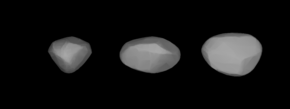900 Rosalinde
Appearance
- There is also an moon called Rosalind (moon).
 A three-dimensional model of 900 Rosalinde based on its light curve. | |
| Discovery | |
|---|---|
| Discovered by | Max Wolf |
| Discovery site | Heidelberg |
| Discovery date | 10 August 1918 |
| Designations | |
| (900) Rosalinde | |
| 1918 EC | |
| Orbital characteristics[1] | |
| Epoch 31 July 2016 (JD 2457600.5) | |
| Uncertainty parameter 0 | |
| Observation arc | 97.33 yr (35548 days) |
| Aphelion | 2.8770 AU (430.39 Gm) |
| Perihelion | 2.0698 AU (309.64 Gm) |
| 2.4734 AU (370.02 Gm) | |
| Eccentricity | 0.16316 |
| 3.89 yr (1420.8 d) | |
| 78.4176° | |
| 0° 15m 12.132s / day | |
| Inclination | 11.563° |
| 182.297° | |
| 122.057° | |
| Earth MOID | 1.08131 AU (161.762 Gm) |
| Jupiter MOID | 2.45968 AU (367.963 Gm) |
| TJupiter | 3.437 |
| Physical characteristics | |
| 9.39±0.7 km | |
| 16.648 h (0.6937 d) | |
| 0.1008±0.017 | |
| 11.74 | |
900 Rosalinde is a minor planet orbiting the Sun. It is named after a character in Johann Strauss's opera Die Fledermaus.[2]
References
- ^ "900 Rosalinde (1918 EC)". JPL Small-Body Database. NASA/Jet Propulsion Laboratory. Retrieved 2 May 2016.
- ^ Paul Herget, The Names of the Minor Planets (1955)
External links
